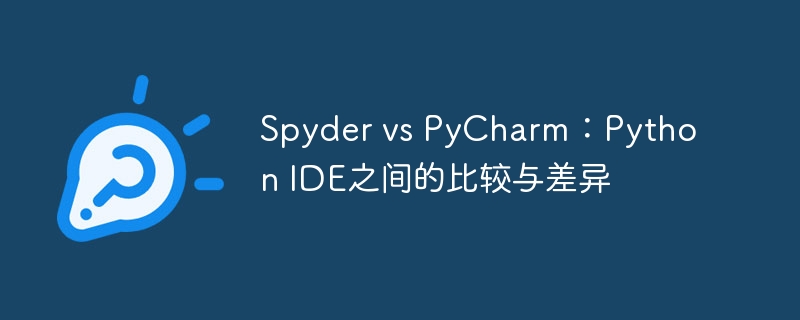

Spyder and PyCharm are two powerful Python integrated development environments (IDEs) that play an important role in the Python development process. This article will compare and contrast these two IDEs, conduct a detailed analysis in terms of interface design, functional features, plug-in support, etc., and demonstrate the differences between them through specific code examples.
1. Interface design and layout
Spyder's interface design is simple and clear, and is mainly divided into multiple sub-windows such as editor, variable viewer, file browser, and command line terminal. The editor supports code highlighting, automatic indentation, code prompts and other functions. At the same time, you can easily view the values of variables, perform debugging and other operations. The overall layout of Spyder is relatively compact and suitable for developers who like a simple style.
PyCharm's interface design is more complex and rich, mainly divided into multiple areas such as editor, project navigation, version control, and terminal. The editor is powerful and supports code automatic completion, reconstruction, debugging and other functions. Project navigation can easily view project files, structure, dependencies and other information. PyCharm's interface is more flexible and the layout can be adjusted according to personal preferences.
2. Comparison of functional features
Spyder and PyCharm have their own advantages in terms of functional features. Spyder is mainly aimed at the field of data science and integrates many data analysis and machine learning libraries, such as NumPy, Pandas, Matplotlib, etc. At the same time, Spyder supports IPython interactive console, which can facilitate data exploration and visualization.
PyCharm focuses more on comprehensive Python development and supports a variety of frameworks and libraries, including Django, Flask, MySQL, etc. PyCharm's debugging function is very powerful and can perform breakpoint debugging, variable monitoring and other operations. In addition, PyCharm also provides rich version control functions and supports version management tools such as Git and SVN.
3. Plug-in support and scalability
PyCharm has a very rich plug-in ecology, and users can expand the functions of the IDE by installing plug-ins. For example, installing the CodeGlance plug-in can display code thumbnails, and installing the Markdown plug-in can realize Markdown syntax highlighting, etc. Through plug-in support, PyCharm can meet the personalized needs of different users.
Spyder's plug-in support is relatively weak, but it has many built-in functions related to data analysis and scientific computing, such as visual viewing of data, drawing charts, etc. For users who focus on data science development, Spyder already provides basic tools and functions, and there is basically no need to install additional plug-ins.
4. Comparison of code examples
The following is a simple Python code example to compare the editor functions of Spyder and PyCharm:
# 示例代码:计算斐波那契数列
def fibonacci(n):
if n <= 1:
return n
else:
return fibonacci(n-1) + fibonacci(n-2)
# 在Spyder中运行以上代码,可以通过变量查看器查看递归调用的过程和结果
# 在PyCharm中运行以上代码,可以通过调试功能设置断点,逐步调试每一步的计算过程As can be seen from the above code examples, Spyder mainly displays the process and results of recursive calls through the variable viewer, while PyCharm uses the debugging function to implement breakpoint debugging, which is more intuitive and convenient.
To sum up, Spyder and PyCharm, as two excellent Python IDEs, have their own advantages and characteristics in different fields and needs. Developers can choose IDE tools that suit them based on their work needs and personal preferences to improve work efficiency and development experience.
The above is the detailed content of Compare and differentiate Spyder and PyCharm: Comparison of Python integrated development environments. For more information, please follow other related articles on the PHP Chinese website!




